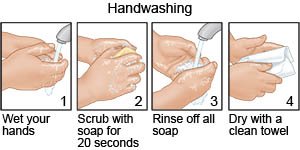Athlete's Foot
Medically reviewed by Drugs.com. Last updated on Nov 3, 2024.
What is athlete's foot?
Athlete's foot is a foot infection caused by a fungus.
What increases my risk for athlete's foot?
Athlete's foot is spread when an infected person shares towels or walks barefoot in shower stalls or public locker rooms. Your risk is greater if you do not wash your feet or do not change your socks every day.
What are the signs and symptoms of athlete's foot?
- Cracks or blisters
- Redness, swelling, itching, or burning
- Scaly or peeling skin
- Bad smelling feet
- Thick, dark skin on the bottoms or sides of your feet
- Thick, abnormal toenails
How is athlete's foot diagnosed?
Your healthcare provider may be able to tell you have athlete's foot by looking at your feet. Your provider may look at a skin sample through a microscope. This will help the provider know the type of fungus that is causing your infection.
How is athlete's foot treated?
Athlete's foot is usually treated with an antifungal medicine. This medicine may be given as a cream or pill. You may need a doctor's order for this medicine. Take the medicine until it is gone, even if your feet look like they are healed. You may also need to soak your feet in an astringent (drying) solution if you have blisters. Ask your healthcare provider for more information on how to treat blisters.
Treatment options
The following list of medications are related to or used in the treatment of this condition.
How can I prevent athlete's foot?
- Prevent the spread of the fungus that causes athlete's foot. After you bathe, dry other parts of your body before you dry your feet. Put your socks on before you put other clothing on. Do not share socks, shoes, towels, or clothing with others.
- Keep your feet clean and dry. Wash your feet each day and dry them well, especially between your toes. Then put powder on your feet and between your toes. Wear clean cotton or wool socks each day. Wear sandals, canvas tennis shoes, or other shoes that allow air to flow to your feet. Do not use shoes that are tight, or made of plastic or rubber. Wear shower shoes or sandals in public and in warm, damp areas. Examples include shower stalls, near swimming pools, and in locker rooms.
- Wash your hands after you touch your feet. Use soap and water. Do not use hand sanitizer on your hands or feet instead of soap and water. Even hand sanitizer that contains alcohol will not kill the fungus that causes athlete's foot.

When should I seek immediate care?
- You have a fever or chills.
- You have red streaks going up your leg.
When should I call my doctor?
- Your infection spreads to other parts of your body.
- Your infection is not better within 14 days or is not completely gone within 90 days.
- The skin on your foot or leg is red and hot.
- You have questions or concerns about your condition or care.
Care Agreement
You have the right to help plan your care. Learn about your health condition and how it may be treated. Discuss treatment options with your healthcare providers to decide what care you want to receive. You always have the right to refuse treatment. The above information is an educational aid only. It is not intended as medical advice for individual conditions or treatments. Talk to your doctor, nurse or pharmacist before following any medical regimen to see if it is safe and effective for you.© Copyright Merative 2024 Information is for End User's use only and may not be sold, redistributed or otherwise used for commercial purposes.
Learn more about Athlete's Foot
Treatment options
Further information
Always consult your healthcare provider to ensure the information displayed on this page applies to your personal circumstances.
